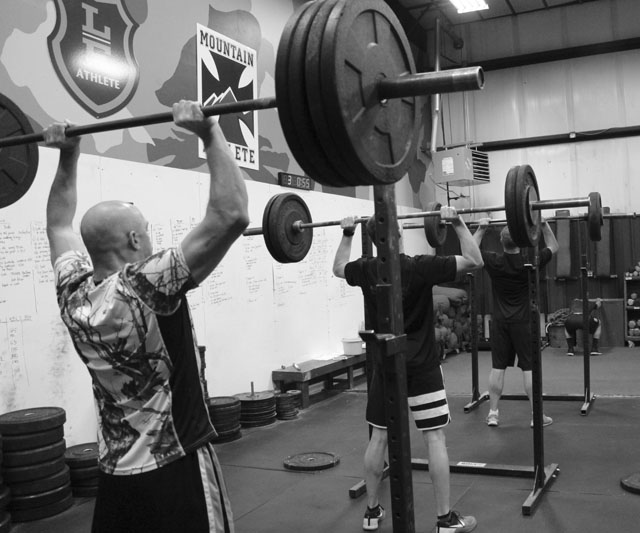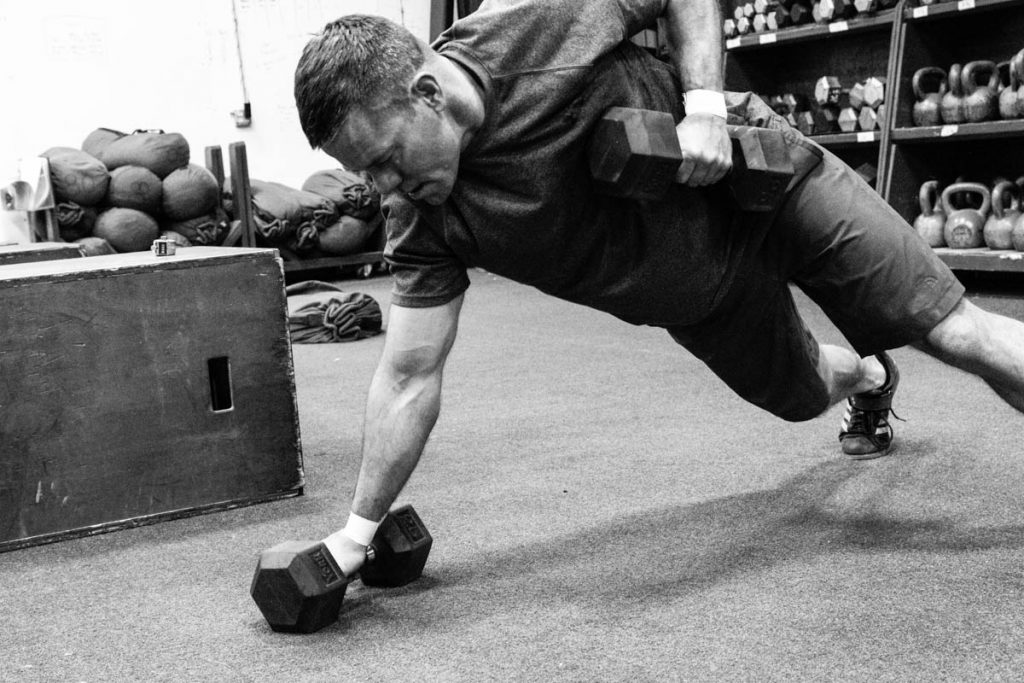
By Rob Shaul
1. Bench Press
I’ve received several emails over the years from CrossFit and other athletes questioning why MTI programmed the Bench Press in its strength sessions. Perhaps it’s my age (50), but I grew up in a weight room long before the functional fitness craze started, and in the old days, the Bench Press was KING!
Forget trying to find an open bench and rack on Mondays after work! All the monster meatheads were doing their heavy sets and if you were a short, skinny, kid like me, asking to “work in” was akin to suicide.
So I’ll admit right up front, one reason the classic Bench Press is one of MTI’s favorite upper body “press” exercise is weight room tradition. And today, even at MTI, the other old guys I train with daily – all in their 40s – enjoy bench press days.
But tradition isn’t the only reason. Many coaches consider the Bench Press the “King” of upper body exercises – with its unique ability to isolate chest, shoulders, and triceps, and allow heavy loading for these muscle groups. I’m one of these coaches.
Watch this video for my 5-6 “Super Secret” Bench Press Secrets ….
As well, from a coaching perspective, it’s pretty darn hard to mess up the bench press technique-wise for new athletes. Certainly, for veteran athletes pushing bench press personal records after years of training, detailed technique can make a huge difference. But for new athletes or the “industrial” athletes I program for, perhaps no other exercise is as simple to complete. The more I coach and program, the more I come to love “simple” – and the bench press fits this bill for upper body strength training.
Finally, I’ve found the bench press and front squat surprising siblings when it comes to comparing an individual athlete’s upper body vs. lower body strength balance. For a balanced athlete, his 1 Repetition Maximum (1RM) Bench press, and 1RM Front squat will be within 10 pounds of each other.
I can always tell who has been a bodybuilding meathead, and who has been a skinny endurance athlete when athletes email me with programming questions and I ask for their 1RM bench press and front squat. The bodybuilder’s bench is always significantly greater than his front squat, and vice versa for the endurance athletes.
This balanced relationship between bench press and front squat 1RM and bench press 1RM also extends to max reps at the same load. For example, our Operator Ugly Fitness Assessment tests bench press max reps and front squat max reps at the same 185-pound load for men, and with balanced athletes, these numbers are very close, if not the same.
2. Push Press
The Push Press is perhaps the most “functional” of all upper body press strength exercises. At work and in daily life, we often have to take something heavy from the floor or ground and push it up onto a shelf, vehicle, etc., high above our heads. If it’s really heavy, we push press it.

Indeed, it’s probably not completely accurate to call the Push Press an upper body press exercise – it could be fairly considered a total body exercise in the way it uses the legs for more push and the core for stability.
One downside to this exercise is it is more “technical” than it seems. It’s not quite as technical as the Jerk, but it’s not a brainless exercise like the Bench Press nearly is. The dip and push need to be timed correctly, and the bar ideally resting on the shoulders in the “rack” position to maximize the force from the legs. This takes technique, and wrist flexibility many of the industrial athletes I work with struggle at. I struggle with it too….
Ideally, the bar travels straight up from the chest on the push – if it doesn’t, and travels a little forward of the athlete, the exercise is much more difficult.
Another issue is that the “sticking point” of the push press, a few inches above the head, can put a lot of stress on the low back. For this reason, when programming, I try not to program push presses and hinge lifts (our version of the deadlift) in the same training session – simply because of the work the low back gets with both exercises.
Why do I favor the Push Press over the strict Military Press? I’ve found it difficult for athletes, when they get heavy with the Military Press, not to use their legs … so I decided not to fight it, and just have them do push presses.
3. Scotty Bob
A tactical athlete visiting the gym taught me this exercise years ago, and at first, the Scotty Bob doesn’t look like a strength exercise. Rarely, if ever, do I adjust loading – women are always at 15-pound dumbbells and men at 25-pound dumbbells.

Why not increase the load? Because the difficulty comes not from raising each dumbbell in the row, but rather knocking out the push ups between row reps.
Scotty Bobs require athletes to do push ups with their hands elevated off the flow on dumbbells and thus increase the range of motion of the push up a couple inches. It doesn’t seem like much, but just try to complete 6 rounds of 5x Scotty Bobs (10 push ups each round) without breaking the final couple sets. Scotty Bobs are no joke!!
Years ago, before I implemented our Garbage Reps exercise restrictions, we had this stupid workout I called the “Fuckin’ 400” – which was 400x total loaded squatting movements – for example, 10 rounds of 10x Front Squats @ 95#. I often programmed 5x Scotty Bobs @ 25# as the “rest” exercise between squat sets, and we came to dread the Scotty Bobs more than the squats!
Scotty Bobs are no joke!
Questions? Email coach@mtntactical.com
Comments? Please enter your comment below.
You Might Also Like MTI’s Favorite Lower Body Pull Strength Exercises